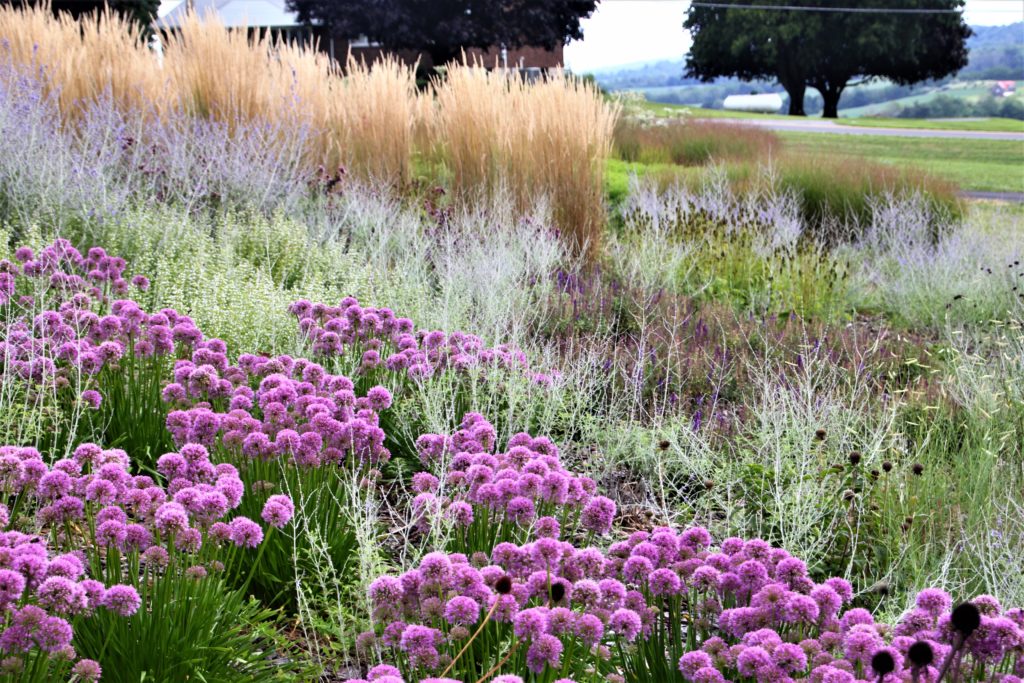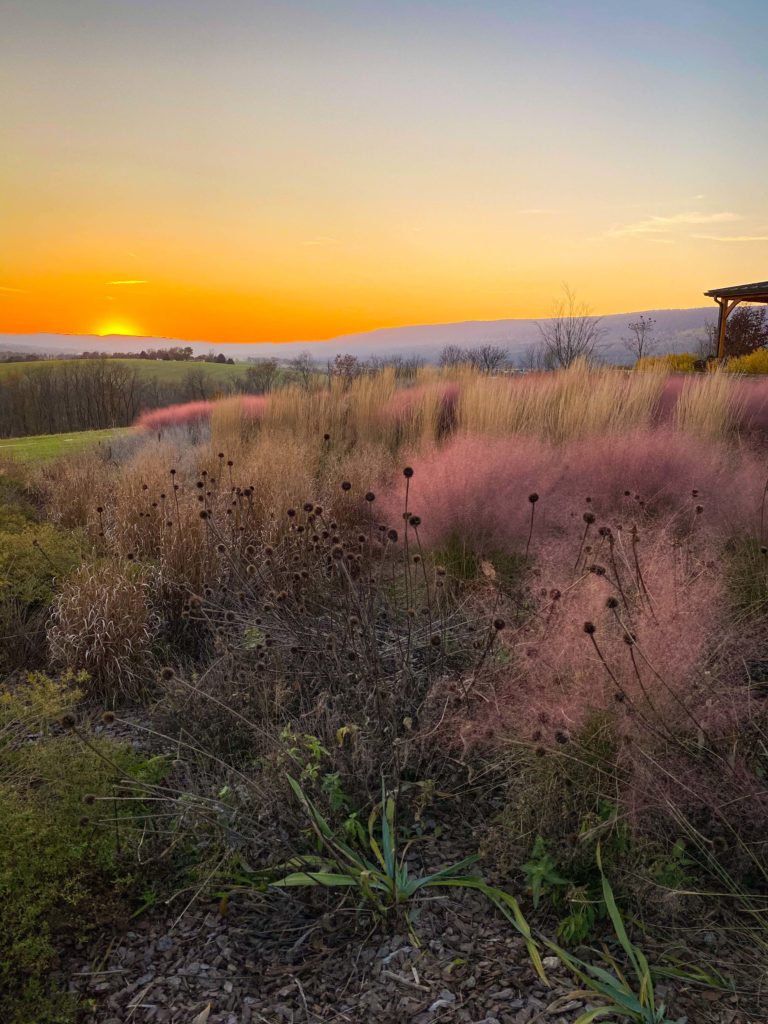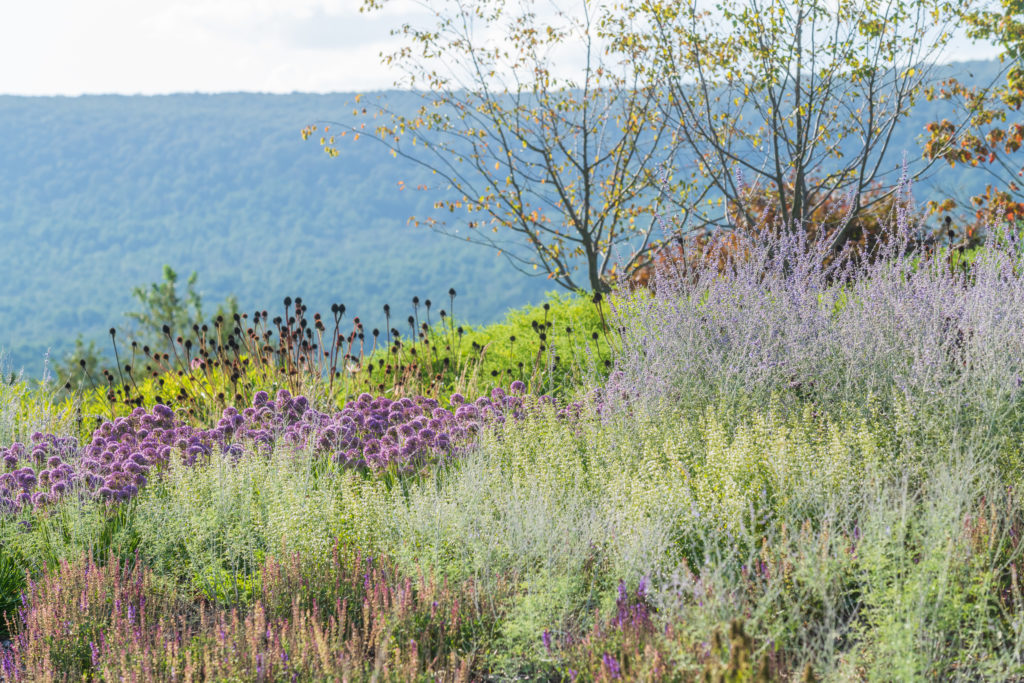Donald Pell translates his impressionistic visions of meadows and forest borders into perennial-filled native landscapes. Drawing from the New American Garden style, Pell seeks to unite gardens designs with regional landscapes.
His designs reflect the nature of the medium. “The notion of a wild garden carries an array of interpretations and emotions. Allowing the garden to seed or evolve is the magic of these places,” Pell says.

An award-winning landscape designer, he calls Pennsylvania home, though he creates gardens throughout the country.
Design
Pell aims to compose designs that celebrate the seasons while focusing on composition. He gained his formal design and horticultural education by working with architects. “I learned the power of thoughtfully developed places,” he notes.
“You are moving through open and expanded places—that is the joy of gardening—experiencing all of the things that happen,” Pell says. Within these spaces, he creates areas that give glimpses of other elements almost beyond view.
Pell does not follow specific design rules. He prefers to mix the science of horticulture with the emotions evoked by plants. Bold masses of perennials offer a beautiful seasonal aesthetic with minimal maintenance.
Creating new landscapes requires an understanding of the role of perennials as successional plants. Some plants live for many years; others are short lived.
One also needs to understand the cultural landscape in which they belong and integrate space, soil, and vegetation, he notes.
Pell considers his designs like paintings. He tries to create the ideal scene or find an elusive image like an impressionist painter. The plants, soil, and topography, among other factors, make each design unique.
Grasses
Pell uses a combination of cool- and warm-season grasses in his landscapes.

“I try to make sure we have enough cool-season grasses like Carexes (sedges),” he says. “Almost the entire family of Carexes are our workhorses,” Pell adds.
Cool season grasses emerge early and thrive in cooler spring and fall temperatures. They outcompete broadleaf plants.
Many Carexes suffer in the summer heat, so, Pell grows Panicum or other warm-season grasses near them to provide shade.
Warm-season grasses emerge more slowly, generally from June to September. A few examples include Sorghastrum nutans (Indiangrass), Schizachyrium scoparium (Little Bluestem), and Andropogon gerardii (Big Bluestem).
They tend to have deep roots and grow taller and “clumpier” than cool-season grasses.
While Pell may use mulch when a garden is first planted, he avoids heavy mulching because it inhibits plants like the Carexes from spreading.
Finding the Right Match
Plants need to be selected with care. Just because a plant is a native species does not guarantee it will be appropriate for a specific garden. Plants need to be suited for the soil in which they will grow. Pell aims to consider all dimensions of the landscape.

While some plants are considered aggressive, like many species of Solidago (goldenrod), it depends on the cultural conditions of the soil, says Pell.
As native plants are early successional plants, they do not need overly rich soils. (Most grow well in poor soil.) Many gardeners, however, have made their garden soils richer than these perennials are accustomed to. The result? They grow more aggressively than they would in native soil. They can overtake a garden and overrun less assertive plants, Pell notes.
“By enriching the soil, we have made more work for ourselves,” Pell cautions. “You need to work with the soil.”
Pell mentions several plants as examples. Monarda didyma (scarlet bee balm) remains relatively well behaved if it is not grown in overly rich soil. Just as Amsonia (blue star), if grown in a sharply drained soil, can colonize and limit a garden’s diversity. Solidago Canadensis (Canadian goldenrod) has been labeled an invasive.
Grasses can also be rambunctious. Some Panicum virgatum (switch grass) seed aggressively, others do not. ‘Northwind,’ a beautiful cultivar, seeds very aggressively. In a few short years it will be a Panicum garden, Pell warns.
Favorite perennials?
When asked to name his favorite plants, Pell responds quickly: “Ones I can get affordably.”
If he cannot get the six types of plants he was planning on, he looks for different plants. “We are open ended with our clients. Some native plants are not available at the end of the season, but at the end of the day, it doesn’t matter. We put plants together,” he says.

Shrubs and Trees: Affordable and Tough
Pell selects native trees and shrubs that are affordable, tough, and locally available. “Make sure the exposure is correct,” he notes.
Among his favorite small trees: Cercis canadensis (Red buds) and Magnolia virginiana (sweet bay magnolia). “I don’t think there is a native tree that I don’t love,” he adds.
His favorite shrubs include Calycanthus (Carolina-allspice) and Aronia (chokeberry, red or black). He enjoys watching bluebirds eat chokeberries at the bush by his window.
Another favorite of Pell’s is the gnarly native species of Nyssa sylvatica (tupelo or black gum tree).
“Nurseries graft Nyssa so it has a stronger central leader to look more perfect,” Pell says, but they have lasted for thousands of years in their original form. They bloom a beautiful yellow for a week. “It is the metaphor for life–imperfect, fleeting beauty,” Pell says with a laugh.
Choosing Healthy Trees
He urges gardeners to purchase healthy trees. It may look healthy, but if its roots have wrapped around the trunk, the tree may strangle to death 20 or 30 years later.
“Too often we buy plants with girdled roots. We train our gardeners to look at the roots. Even at the best nurseries, it’s amazing how many have bad root balls. We keep tools to check girdling, such as an air spade,” he says.
Life-Friendly Gardening
Pell takes a pragmatic approach to every aspect of gardening. He prefers to create gardens that people do not have to think about all the time.
“Gardens shouldn’t be an added burden,” he says. “We are all busy.”

Pell advises gardeners looking to expand their collections to try dividing plants. “A mountain mint plug grew to 4’ in diameter in a year,” he notes. While not all plants will grow that vigorously, most can be divided successfully.
“When the recession hit, I had a 14-acre farm with a studio and gardens. I had nothing to spend, [so] I planted plants.
“I am a gardener, not a nurseryman. I planted seeds and made divisions to get more plants for less. If you are not afraid of failure— get out there and start doing it! And have a little more fun,” he added with a chuckle.
The Best-Laid Plans
For the first time this year, Pell and his team will be exhibitors at the Philadelphia Flower Show.
“I am relying heavily on one native shrub,” says Pell about his exhibit. “Generally, it blooms during the week of [this year’s] Flower Show.
“We went over the top and bought a number of these plants,” he adds. “We had a spike in temperature, and it started blooming.” Pell laughs as he recounts seeing the shrub blooming in mid-April, two months before the show. “The best-laid plans,” his voice trails off in another laugh.
To find out how this story ends, you will have to visit the show.
